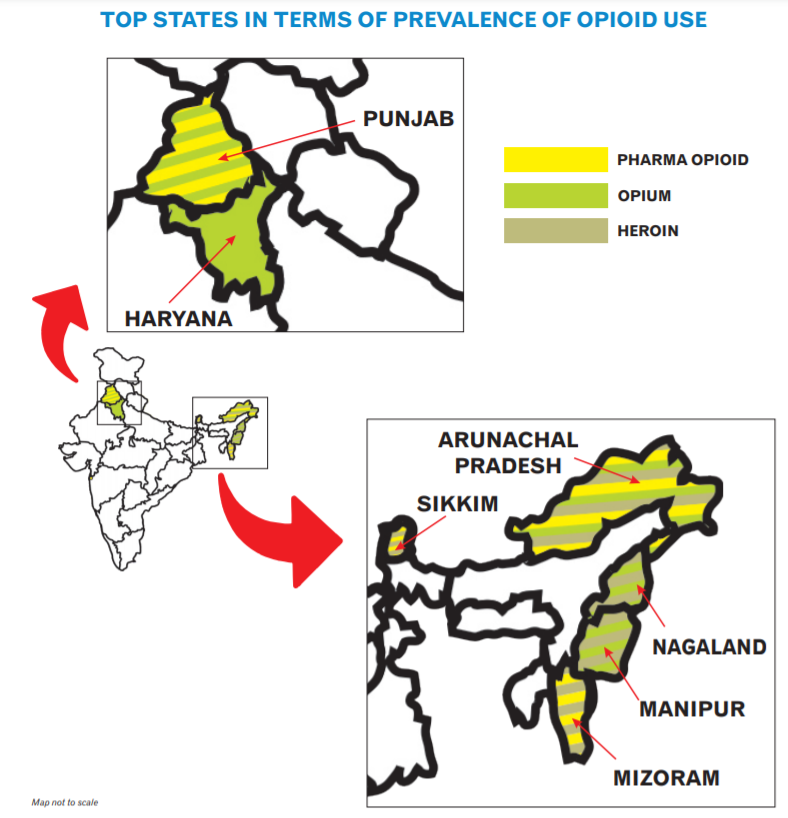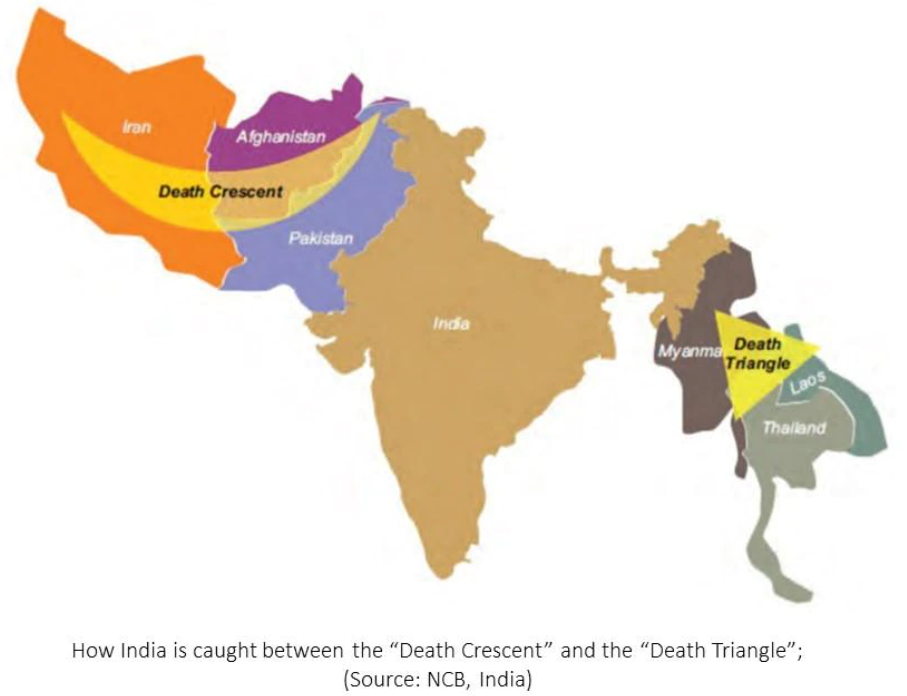Punjab’s Drug menace
2023 APR 27
Mains >
Security > Border area management > Women and Child issues
IN NEWS:
- Ahead of the parliamentary by-election, opposition parties have sharpened their attack on the ruling government in Punjab over the state’s drug menace.
PUNJAB AND DRUG MENACE:
- Abuse of psychotropic drugs has been Punjab’s scourge for over two decades.
- Chandigarh`s Post-Graduate Institute of Medical Education and Research (PGIMER) stated that more than 3 million people, or around 15.4 per cent of the population of Punjab, are currently consuming drugs.
- As per the NCRB data, Punjab is placed third in the number of drug trafficking cases. However, the state’s crime rate of 32.8 per lakh population in this category remains at the top in the country.
- The rate means about 33 persons per lakh indulged in drug smuggling.

WHY DRUG ISSUE IS SEVERE?
- Proximity to producing areas:
- India is sandwiched between the Golden Crescent and the Golden Triangle. This proximity has made India both a destination and a transit route for opiates produced in these regions.

- Ready availability within the country:
- Illicit cultivation of opium poppy still occurs in India.
- Also, India is a licit supplier of opium to the international pharmaceutical industry. However, despite strict controls, some portion of this product is diverted, which adds to the availability of drugs on the market.
- Easy access to entry level drugs:
- They are habit-forming substance that can lead a person to use other stronger, more addictive drugs. Entry level drugs like alcohol and prescription pills are easily available in the country.
- Eg: Over the counter sale of Psychotropic drugs like sedatives and opiates, which come under the prescription medicines.
- External state actors:
- Pak-backed crime syndicates and terrorist units thrive on cross-border narcotic trade.
- New routes and modes of trafficking:
- The maritime route has become more active after the recent developments in Jammu and Kashmir.
- The use of drones to supply drugs and weapons across the border in Punjab is a new phenomenon.
- Darknet markets, cryptocurrency payments and doorstep deliveries are disrupting traditional drug markets because of their anonymity and low risks.
- P-P-P Nexus:
- The Police-Politician-Peddler nexus is an open secret in Punjab. Many Punjab cops, jail officials, and employees of BSF, Railway Protection Force and Chandigarh Police have been arrested for their involvement with drug gangs.
- Local support:
- For many in the rural and border regions of India, drug trade is a means to secure livelihood and escape poverty. Hence, smugglers often get support from locals.
- Flawed approach to drug consumption:
- State policy of controlling drug trade and usage has traditionally been punitive in nature since the usage of drugs is treated as a criminal law issue.
- Legal loopholes:
- According to the present provisions of the NDPS Act, a seizure of less than five grams of heroin can lead to smaller imprisonment and fines. Moreover, the suspect can easily secure bail. In order to take advantage of the legal loopholes, most of the trafficking takes place in small quantities.
- Stagnant economic growth:
- Economic stagnation and lack of quality employment is seen as a major contributor to increasing drug use.
- For instance, Agriculture, which brought Punjab its wealth, is stagnant. Unemployment level in Punjab stood at 21.6%, while the national unemployment average is 17.8%. Hence, frustrated population are getting attracted to drug abuse.
- Social factors:
- The disintegration of the old joint family system, absence of parental love and care in modern families, decline of old religious and moral values etc. lead to a rise in the number of drug addicts who take drugs to escape hard realities of life.
- Glorification of drug use:
- Popular media, like rap songs and Bollywood movies, glorify the use of psychotropic drugs, which further attracts youth into trying them.
CONCERNS:
- Law and order issue:
- Drugs remove inhibition and impair judgment egging one to commit offences. Incidences of teasing, group clashes, assault, resorting to crime to pay for drugs and impulsive murders increase with drug abuse.
- Narco-terrorism:
- Narcotic drugs are the main source for funding terrorist activities in Punjab and Jammu and Kashmir where the Pakistan government overtly sponsors terrorism.
- On health:
- Apart from the long-term damage to the body drug abuse causes, drug addicts who use needles are also at risk of contracting HIV and hepatitis B and C infections.
- On women:
- Studies have shown that drug abuse among women is also on the rise. But due to social stigma, state of denial and lack of exclusive facilities, women are not seeking help and often fall victim to sexual abuses and threat to life.
- Loss of demographic dividend:
- An AIIMS Delhi study in 2019 revealed that 76% of opioid dependents in Punjab were aged 18-35 years. This is a matter of serious concern, as it would result in India’s young demography becoming a demographic burden.
- Treatment gap:
- The National Mental Health Survey (2015-2016) showed a treatment gap of more than 70 % for drug use disorders. Further, merely 5% of people with illicit drug use disorders received inpatient care.
- Data on women substance users is scanty and the number of de-addiction centres for women are woefully short.
- Human rights violation:
- Rampant irregularities and torture of inmates are prevalent at the de-addiction centres. The right of basic human dignity of persons desperately in need of care and treatment is being violated with impunity.
|
Maqboolpura: The village of widows
One of the worst affected areas of the crisis is Maqboolpura, on the edge of Amritsar. So many of its men have died or deserted their families after becoming addicted that it has become notorious for being "the village of widows". The small locality of about 25,000 residents, who settled here primarily as refugees immediately after the Partition, is known as the Village of Widows and Orphans owing to the deaths of more than 400 people, (most of them alleged addicts) since 1999.
|
GOVERNMENT EFFORTS:
- The Ministry of Social Justice and Empowerment is the nodal Ministry for drug demand reduction.
- Narcotic Drugs and Psychotropic Substances (NDPS) Act, 1985
- Defines the various narcotic drugs and psychotropic substances, lays out the Prohibition, Control and Regulation of the previously mentioned substances.
- Describes the punishment duration for various possible crimes that can be tried under this Act.
- Narco-Coordination Centre (NCORD) under Ministry of Home Affairs is tasked with combating drug trafficking and the use of illegal substances under the provisions of Narcotic Drugs and Psychotropic Substances Act.
- Nasha mukt Bharat:
- Annual Action Plan for 2020-21 would focus on 272 most affected districts.
- It is a three-pronged attack combining efforts of Narcotics Bureau, Outreach/Awareness by Social Justice and Treatment through the Health Dept.
- International cooperation:
- For effective coordination with foreign countries, India has signed 37 Bilateral Agreements/Memoranda of Understanding.
- State government efforts:
- Punjab and Haryana governments are undertaking efforts to reduce supply, demand and consumption of drugs. This includes Special Task Force (STF) in Punjab, border patrols by security forces and police, opioid assisted treatment clinics and other rehabilitation facilities.
- Technological efforts:
- Modern technological innovations such as Night Vision Devises, Hand-Held Thermal Imagers, Battle Field Surveillance Radars, Long Range Finders and High-Powered Telescopes are being used along the borders.
|
“Mera Pind-Mera Maan”:
- Mansa district in the State is deploying youth energy to prevent idle time and potential addiction. The motto: ‘mera pind-mera maan’ (my village, my pride).
- They run campaigns on single-use plastics, stubble burning, tree planting, road safety, and against drugs.
- As a result of the youth’s efforts, 70% of people here today use cloth bags, stubble burning in the village is down by 60%, the streets are clean and green, and the walls shout out positive messages.
|
WAY FORWARD:
Supply side:
- Create a Joint institutional mechanism where the state police, BSF, DRI, NCB, Intelligence Bureau and other important agencies are represented. This joint platform will help in better coordination among various agencies, creating synergy and avoiding overlap in operations.
- Improvement of security infrastructure and surveillance capability at India-Pakistan border should be accorded priority.
- The Central and state governments should develop ways of providing additional focus on anti-corruption measures, the modernisation of the police as well as judiciary.
- The government can think of recruitment of ‘Border Volunteers’ from the border villages, as this practice has proved successful in many crime-infested areas.
Demand side:
- Community policing can play a meaningful role in building partnerships with parents and community leaders to become mentors for the prevention and treatment of drug abuse.
- The government should encourage sports and other recreational facilities for youth, so that they can focus on healthy and productive ways of spending their free time.
- Regular assessment and feedback of ground realities of the anti-drug drive.
PRACTICE QUESTION:
Q. The bane of drug abuse is acquiring the proportions of a pestilence that threatens the internal security of the country. Discuss the reasons behind the drug menace in India. What measures have the government taken to address the issue?

